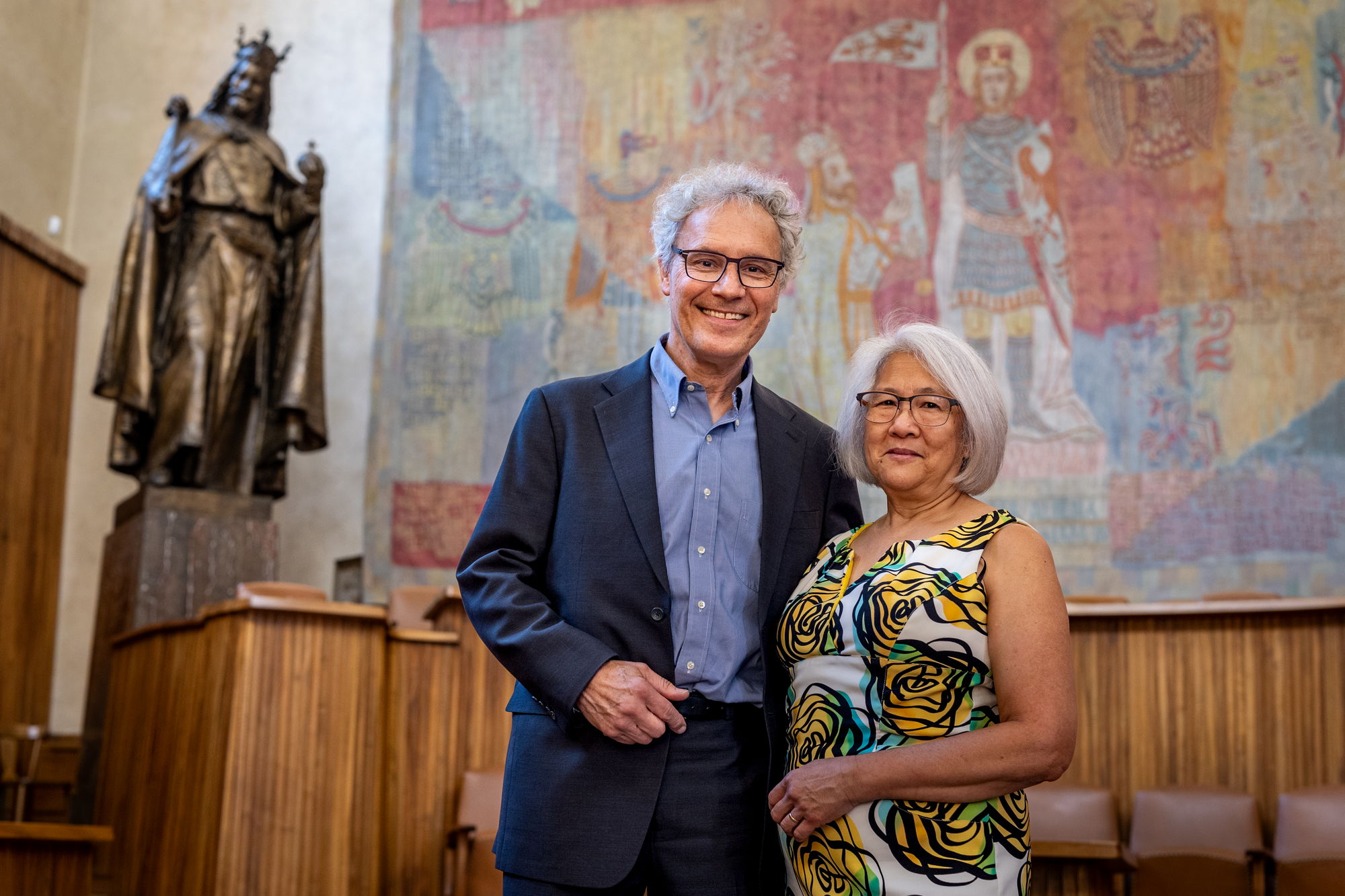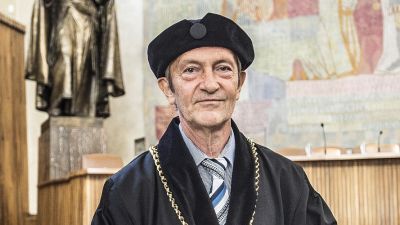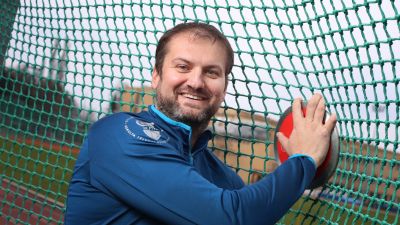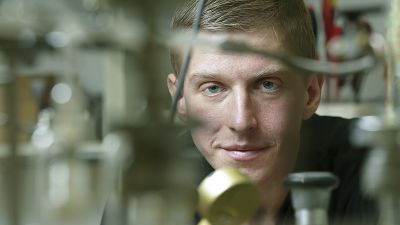Victor Ambros, awarded the Nobel Prize in Physiology or Medicine in 2024, is an American molecular biologist renowned for his pioneering discovery of microRNAs—tiny RNA molecules that regulate gene expression and play crucial roles in development, physiology, and disease. His groundbreaking work has transformed biology’s understanding of genetic regulation and opened paths toward new therapeutic strategies.
He has long collaborated with his wife, Candy Lee Ambros, who has served as his laboratory manager and co-researcher for decades. This interview was conducted on Victor Ambros’s and his wife’s visit to Charles University. Forum magazine had the opportunity to ask both a few questions.
What was your strongest emotion when you were awarded the Nobel Prize? What did you feel when you first learned about it?
Surprise. We were very surprised. That was the first emotion. Then apprehension about what is now going to happen, that we will not be able to control. That very day was scheduled, instantly filled with press conferences, departmental and university-wide celebrations, a visit with the president of the university, and so on. We knew that for at least a few days or weeks our schedule was no longer under our control.
Was winning the prize a game changer for you and your team? Did it change your research path?
It didn’t really change our research direction. Everything we’re doing now was already planned. We’ve continued with the projects we had set out, including work with the Argonaut Alliance and our collaborators focused on understanding and hopefully curing Argonaut Syndrome, a rare disease. That’s actually the meeting we are heading to here in Prague as well. But the Nobel Prize did help accelerate the project—we were able to convene collaborators more effectively and move things along faster than we otherwise could have.
Was there ever a moment when you consciously sought the Nobel Prize? Could winning it be a motivation for a scientist? Or perhaps it shouldn’t be motivation at all?
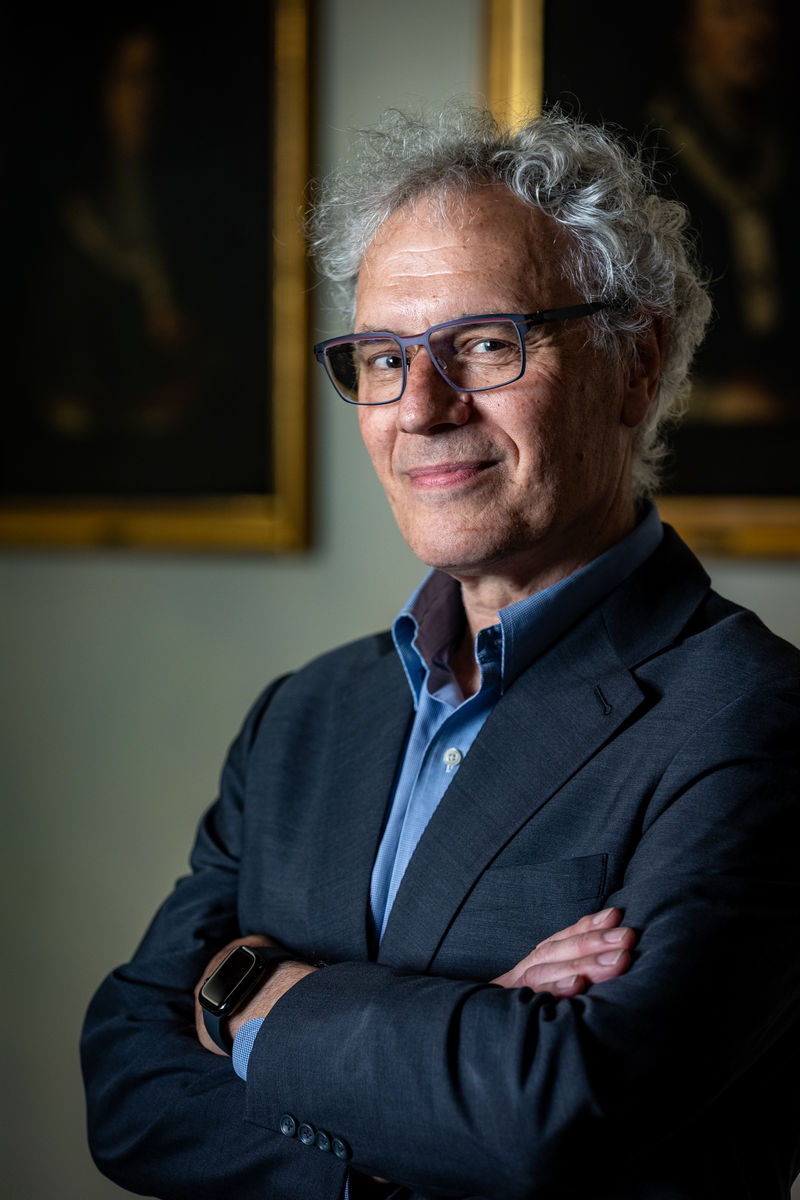 Once we moved to the University of Massachusetts in 2008, people there seemed to expect that Victor would win the Nobel Prize. That was a surprise to us—we didn’t know. Each year the university even had a schedule prepared, and in late September they would ask where we would be the first Monday or Wednesday in October, and what phone number to reach us on the day of the announcement. We thought it was sweet of them to think like this, but it also made us very anxious. It was a lot of pressure. Each October we would be tense and then relieved when the announcement passed. But for about 16 years, nothing happened. Eventually UMass gave up and stopped sending those emails. The Chancellor admitted that he would always plan to be on campus during that week, except last year. He was in Greece. And even the chair of the department gave up. Because he used to keep champagne ready in the fridge, but by the end he had to borrow some from another lab. So, when the call finally came, it was a surprise to everybody.
Once we moved to the University of Massachusetts in 2008, people there seemed to expect that Victor would win the Nobel Prize. That was a surprise to us—we didn’t know. Each year the university even had a schedule prepared, and in late September they would ask where we would be the first Monday or Wednesday in October, and what phone number to reach us on the day of the announcement. We thought it was sweet of them to think like this, but it also made us very anxious. It was a lot of pressure. Each October we would be tense and then relieved when the announcement passed. But for about 16 years, nothing happened. Eventually UMass gave up and stopped sending those emails. The Chancellor admitted that he would always plan to be on campus during that week, except last year. He was in Greece. And even the chair of the department gave up. Because he used to keep champagne ready in the fridge, but by the end he had to borrow some from another lab. So, when the call finally came, it was a surprise to everybody.
But no—the Nobel prize was never a motivation. People often ask what the steps are to win it. But there are no steps. It’s largely luck—being observant when something unexpected appears. Many scientists notice strange results and dismiss them as mistakes. We were very, very lucky to pursue one of those oddities.
There are many smart people in science. In biology, it’s almost impossible to predict what the next discovery would be. Because biology is always surprising. You can’t decide, “I’m going to make this huge discovery that will win a Nobel Prize,” and do it, because nobody knows what that discovery will be. But we know that if we work on something that we are super interested in, and colleagues around us are interested in, and the students are interested in, and it’s really a fascinating problem, you know that will be a productive use of your energy and your career. That will produce something new—but whether it’s transformative or modest, you can’t know in advance.
In our case, it was something completely unexpected. Nobody had ever described these tiny microRNAs before. We weren’t looking for them, nobody even imagined they existed. And then we found the first one. You’re searching for objects in the universe and suddenly find something nobody has noticed before.
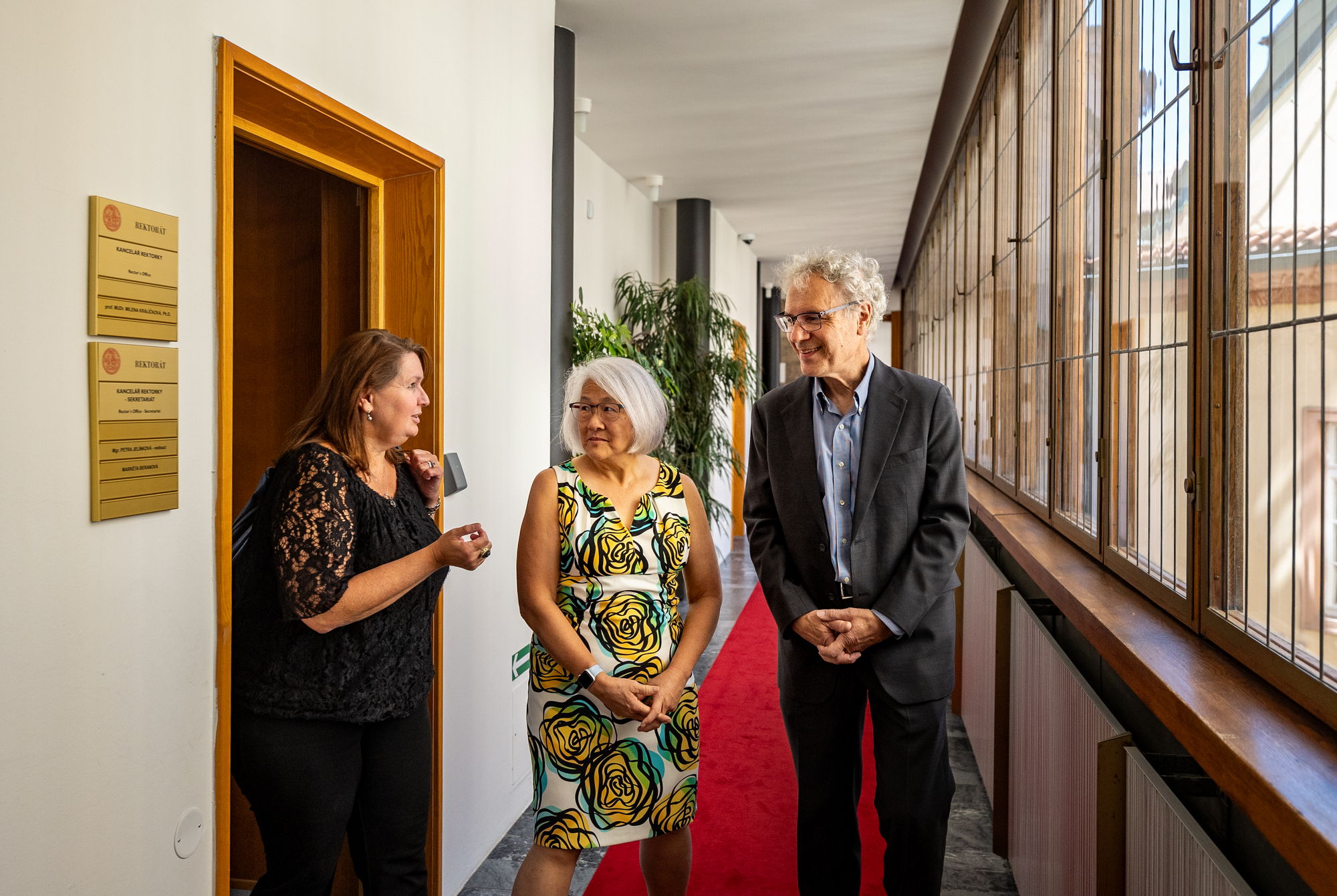 Victor Ambros and his wife Candy Lee Ambros visited Charles University at the invitation of Rector Milena Králíčková and toured the historic Karolinum building.
Victor Ambros and his wife Candy Lee Ambros visited Charles University at the invitation of Rector Milena Králíčková and toured the historic Karolinum building.
Over your life as a researcher, and now as a Nobel prize laureate, what has helped you most in overcoming obstacles and dead ends? How did you keep going at times when your work wasn’t appreciated, for example, when you first published in 1993 about microRNAs, and at first, no one seemed to react? What kept you moving forward?
When we discovered microRNAs in this little worm, C. elegans (Caenorhabditis elegans), it interested only a very small field of scientists. But we were fortunate that the editor of the very important journal Cell was intrigued, so we could publish there, alongside a paper from Gary Ruvkun’s lab. We were proud of those two papers together—it was very good work and a new discovery.
But generally, people looked at that, including us, and thought this could be just something that happened to be evolved in the little worm and not relevant for other animals. My wife Candy even looked for that particular microRNA in the human genome. And it turned out it is in this genome, as we know now, but the methods available at the time couldn’t find it. Only after genomes were sequenced could it be identified.
We published more papers, but for years, the field was super small, just two or three labs. Then in 1999, advances showed that microRNAs were present across all animals, even plants. That year was a turning point. Suddenly, what seemed like a peculiar worm phenomenon became something of broad importance to almost everybody.
So the lesson learned is: never give up if you’re convinced something matters?
Exactly. And meanwhile, we were publishing, learning about mechanisms, making progress. Still, it was worrying. Funding agencies like the National Institutes of Health want relevance to humans, and for a long time, it wasn’t clear whether our work had that. It took about six years before its broader significance was recognized.
Has any of your research already resulted in clinical applications?
Not our research, no. But there are microRNA-based therapeutics being developed, and even more progress in related small RNA therapeutics based on RNA interference. Many companies are now developing therapies that use these small RNAs, which function with Argonaute proteins.
MicroRNAs themselves have been most valuable for understanding better biological phenomenon, physiological, regulation, disease mechanisms. And, as we mentioned earlier, Argonaute syndrome is one striking example: a mutation in Argonaute protein disrupts microRNA regulation. We’re working on this project with an international team, aiming both to understand the physiology of the disease better and eventually to develop therapies.
“If we work on something that we are super interested in,
and colleagues around us are interested in, and the students
are interested in, and it’s really a fascinating problem,
we know that will be a productive use of our energy and our career.”
You’ve worked extensively with the C. elegans roundworm. With new technologies such as CRISPR-Cas9, is research with model organisms still important?
If you’ll excuse me—hell yes! Model organisms are just as important as ever. In the Argonaute syndrome project, for example, our role is to use C. elegans as a biological vessel to test the effect of some of the mutations. We can do this very quickly because of its short life cycle. With CRISPR-Cas9 gene editing, we can introduce mutations efficiently.
There’s a constant exchange between human genetics and model organism genetics. Quick, efficient experiments in worms can inform human physiology and guide our collaborators’ work. And C. elegans continues to yield new discoveries in its own right. Researchers are studying learning and memory, neural integration, and behavior. Despite having only 302 neurons, the little worm shows a remarkable range of complex behaviors. With modern imaging and genetic tools, it’s a powerful system for neuroscience.
For example, a former postdoc of mine, studies prion diseases—protein aggregates linked to Alzheimer’s and similar conditions. C. elegans is proving to be an excellent system for investigating the mechanisms behind those processes. So yes, model organisms will continue to deliver important surprises, shaping research directions in humans and other mammals as well.
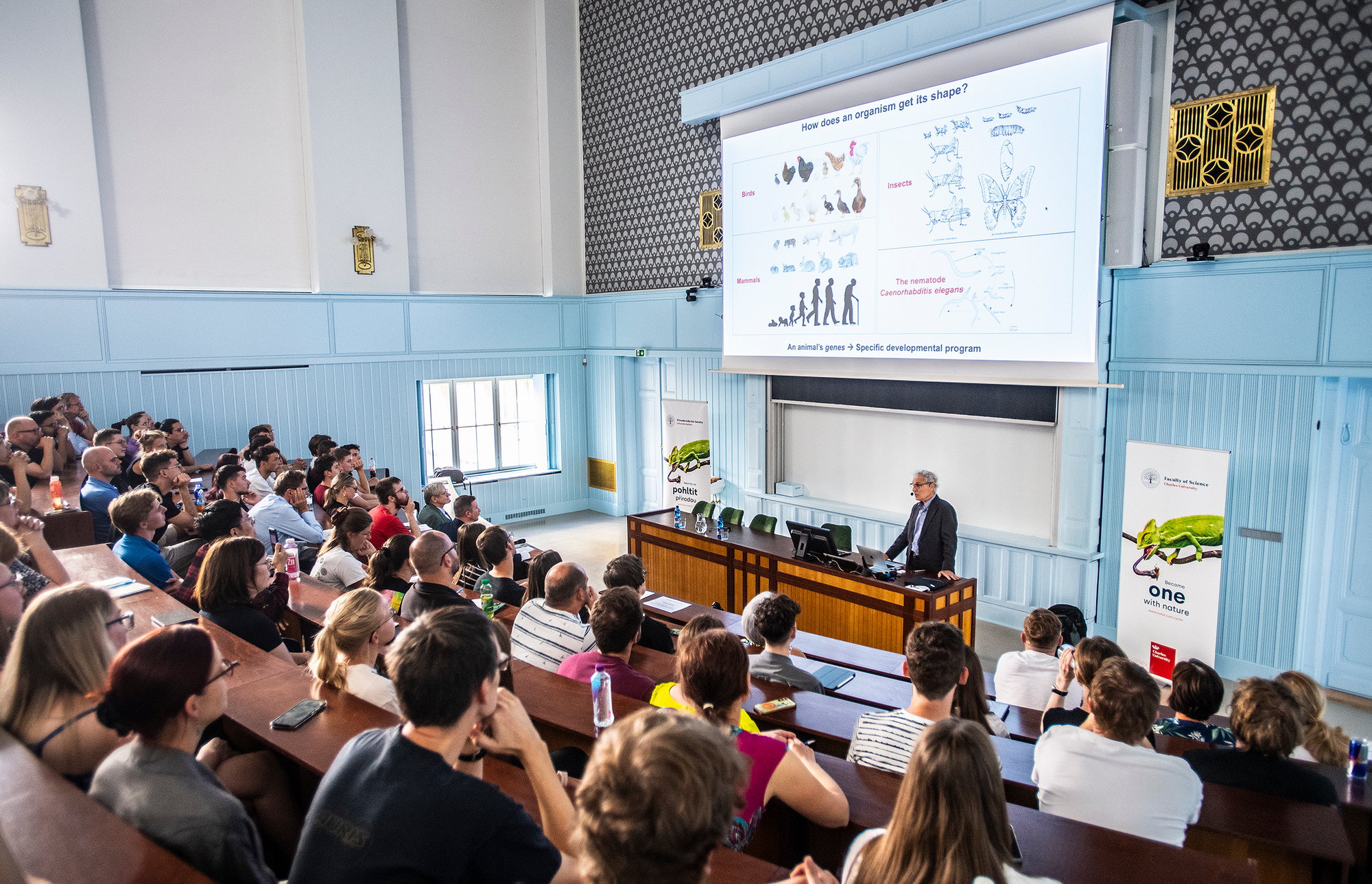 Nobel laureate Victor Ambros gave a lecture titled “Development timers in a tiny worm!” during his visit to Charles University in the Great Geological Lecture Hall of the Faculty of Science. Over 200 people attended the lecture.
Nobel laureate Victor Ambros gave a lecture titled “Development timers in a tiny worm!” during his visit to Charles University in the Great Geological Lecture Hall of the Faculty of Science. Over 200 people attended the lecture.
Do you already have any collaborations with Czech teams, at Charles University or the Academy of Sciences?
Not yet. I don’t think we’ve collaborated with anyone from the Czech Republic so far. But many collaborations start through personal connections, so being here could very well lead to future partnerships.
With the Trump administration and the changes happening in the United States, has it become more difficult for scientists to collaborate internationally?
Much more difficult! For one thing, the Trump administration canceled all grants that included overseas partners. That funding simply disappeared, which had a major impact, also on labs in Europe that relied on those collaborations.
The situation in the U.S. itself has been disastrous—worse than you can imagine. Universities had to cut back on their research enterprises dramatically. For example, many U.S. researchers work on drug-resistant tuberculosis, but we don’t have the patient population in the U.S.—we have it elsewhere. Funding for that research was cut, so those projects collapsed.
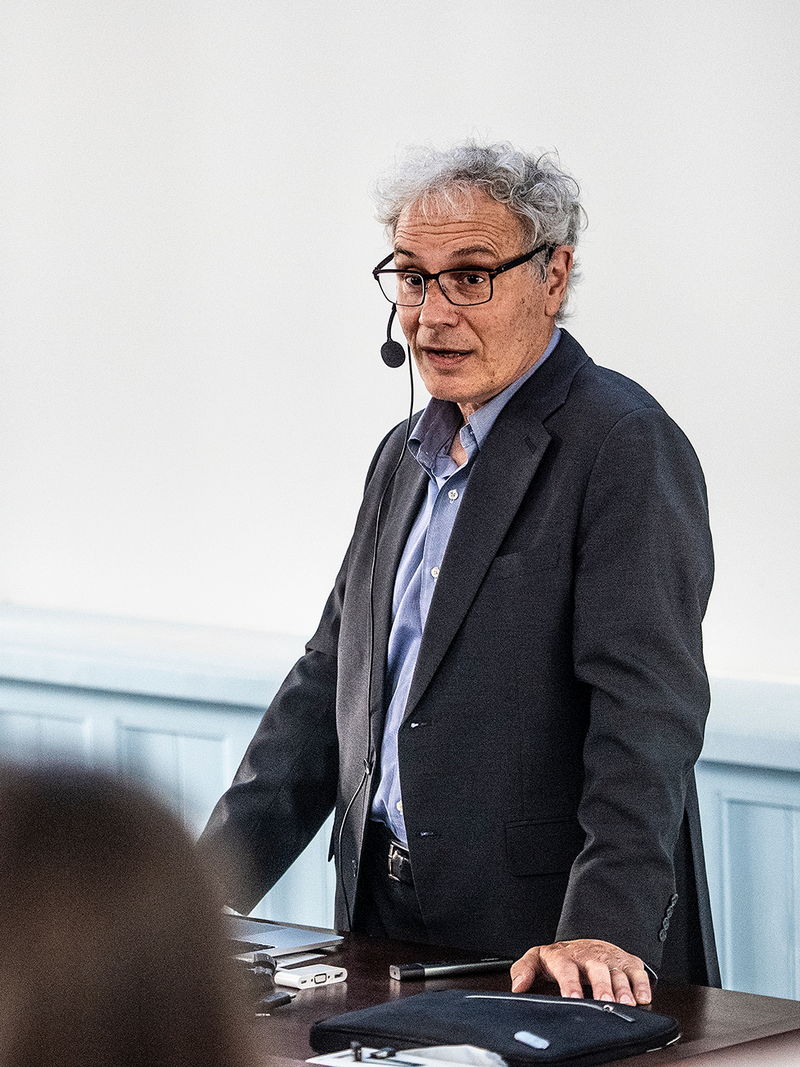 Universities have had to lay off staff and cancel graduate programs. They aren’t recruiting new faculty, even though there are thousands of young scientists ready to step into those positions. They now have nowhere to go. So many of them are leaving for Canada, Europe, or Asia. The U.S. is losing thousands and thousands of young people.
Universities have had to lay off staff and cancel graduate programs. They aren’t recruiting new faculty, even though there are thousands of young scientists ready to step into those positions. They now have nowhere to go. So many of them are leaving for Canada, Europe, or Asia. The U.S. is losing thousands and thousands of young people.
The others thing that is disastrous is how this has disrupted profoundly the international nature of U.S research. At every U.S. university, the majority of scientists come from abroad, and many want to stay in the U.S. Now, they no longer feel confident they can remain. Many of them have been sent away. Some of them have even been arrested on the streets, deported.
I know of cases where international scientists were detained while abroad and prevented from returning. Is that true?
Yes. Nobody wants to leave the country, and nobody wants to come in. That has created enormous fear. People don’t want to leave the U.S. because they worry they won’t be allowed back in. Attendance at international conferences has dropped sharply for the same reason.
One of our French graduate students, for example, was afraid to go to Canada for her brother’s wedding because she wasn’t sure she would be allowed back into the U.S. The administration has succeeded in making everybody afraid about everything, creating an atmosphere of fear, undermining the very fabric of how research is conducted. Every detail of scientific life—collaborations, travel, conferences—has been threatened by fear.
The change has been breathtaking, a complete reversal of how the U.S. relates to the scientific community. But we are fighting this, and we will not let it become permanent.
One last question: you are life partners and collaborate as scientists. How does that work, Candy?
In fact, I was the one who did the laboratory work for the Nobel price-related discovery (smiles). I’ve been working with Victor for about forty years. After I graduated, I worked elsewhere for a while, but once he had his own lab, I joined him. Since then, I’ve been his lab manager. We work together in life and in the lab.
| Victor Ambros is an American molecular biologist and professor at the University of Massachusetts Medical School. He is renowned for discovering microRNAs, small RNA molecules that regulate gene expression, a breakthrough that revolutionized biology and medicine. In 2024, he received the Nobel Prize in Physiology or Medicine. |
| He has long collaborated with his wife, Candy Lee Ambros. She is a scientist and was the first author of the seminal 1993 paper that contributed to the discovery of microRNA, the discovery for which her husband, along with Gary Ruvkun, received the 2024 Nobel Prize in Physiology or Medicine. Lee is a valued scientific collaborator, the lab manager of Victor Ambros and was acknowledged by Ambros as being vital to his work. |
